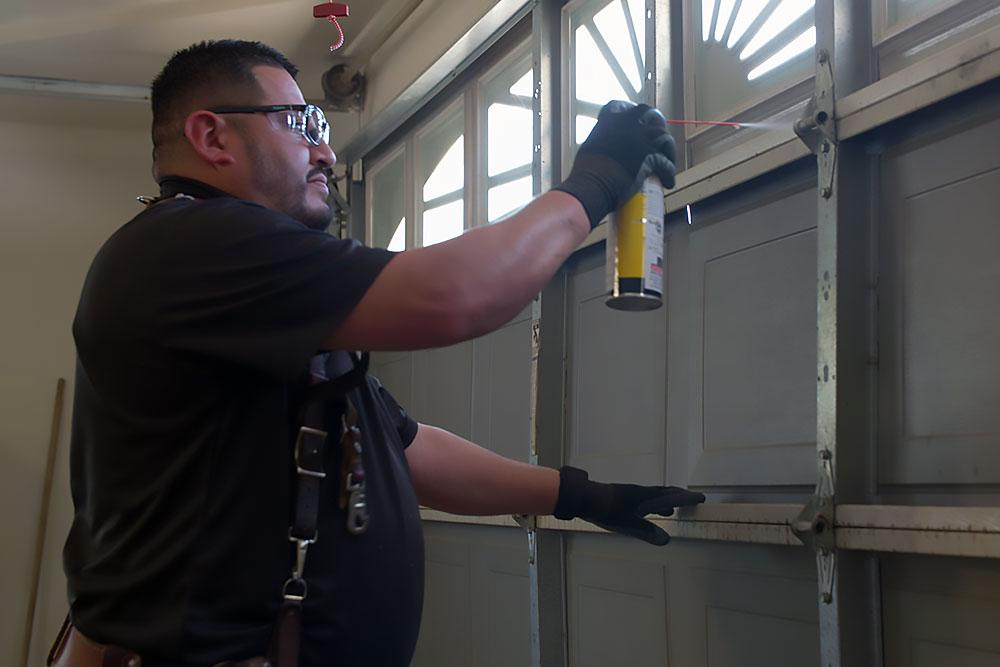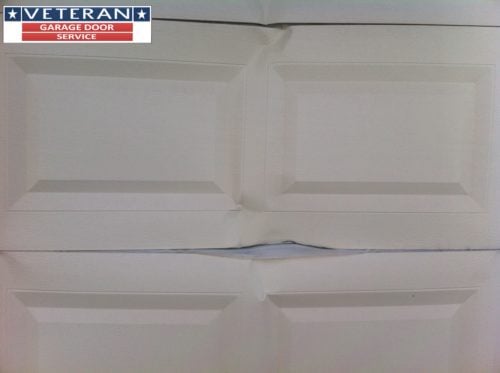To fix a hole in a garage door, first clean the area, then apply a metal patch and sealant. Addressing a hole in your garage door promptly is crucial for maintaining its functionality and ensuring your home’s security.
A damaged garage door can compromise insulation, leading to increased energy bills and potential safety hazards. It’s essential to tackle the problem immediately to prevent further damage and maintain the aesthetic appeal of your home’s exterior. Repairing a hole in your garage door not only enhances its performance but also contributes to the overall value of your property.
With the right tools and a bit of know-how, this task can be a straightforward DIY project, ensuring your garage door remains in top condition while saving you the cost of a professional repair.

Credit: cagaragedoors.com
Introduction To Garage Door Repairs
Your garage door is a critical part of your home. It provides security and convenience. But when a hole appears, it’s a sign that repairs are needed. Understanding garage door repairs is essential to maintaining your door’s integrity and function.
Common Causes Of Holes
Holes in garage doors can arise from many sources. Common culprits include:
- Accidental Damage: Collisions with vehicles or equipment.
- Weather: Harsh conditions leading to wear and tear.
- Rust: Metal doors can corrode over time.
Safety Precautions Before Starting
Before attempting repairs, safety comes first. Always:
- Disconnect Power: Turn off power to prevent accidents.
- Wear Protective Gear: Use gloves and safety glasses.
- Secure the Door: Ensure it won’t move while you work.
Tools And Materials Needed
When your garage door gets a hole, it’s time to fix it. You need the right tools and materials. Let’s gather everything needed for a smooth repair.
Essential Repair Kit Items
- Safety goggles: Protect your eyes.
- Work gloves: Keep your hands safe.
- Measuring tape: Measure the hole size.
- Utility knife: Cut out damaged areas.
- Sandpaper: Smooth the edges.
- Paintbrush: Apply primer and paint.
- Putty knife: Spread filler material.
Choosing The Right Filler Material
| Type of Hole | Filler Material |
|---|---|
| Small | Auto body filler: Dries fast, strong. |
| Medium | Metal patch kit: Easy to shape, durable. |
| Large | Sheet metal: Cut to fit, lasts long. |
Assessing The Damage
Before fixing a hole in a garage door, assessing the damage is key. This step helps decide the best fix method. Let’s dive into how to accurately assess the damage.
Determining The Size Of The Hole
To start, measure the hole’s width and height. Use a ruler or tape measure. This will help in choosing the right materials for the repair. Small holes often need simple fixes like filler or patch kits. Large holes might require more materials, like new metal sheets or panels.
- Small holes: Less than 3 inches across.
- Medium holes: Between 3 to 6 inches.
- Large holes: More than 6 inches.
Evaluating Repair Vs. Replacement
Next, consider whether to repair or replace the damaged section. This depends on the hole’s size and your garage door’s overall condition.
| Hole Size | Action |
|---|---|
| Small to Medium | Repair |
| Large | Consider Replacement |
A repair is often enough for small to medium holes. For large holes, or if the door is old, replacing might be better. New doors offer more security and can improve your home’s look.

Credit: diynovice.wordpress.com
Preparation For The Repair
Before diving into the actual repair, preparing is key. A well-prepared surface ensures a smooth repair process. Follow these steps to get your garage door ready for the fix.
Cleaning The Affected Area
Start with a clean workspace. Dust and dirt can hinder the repair materials from adhering properly. Use a clean cloth and mild detergent to wipe down the area. Rinse with water and let it dry completely.
Removing Loose Debris
Next, remove any loose particles. Small fragments can create uneven surfaces, leading to a less stable repair. Gently scrape off peeling paint or rust with a putty knife. Vacuum any residual debris for a clean surface.
The Filling Process
The Filling Process is a key step in repairing holes in garage doors. With the right tools and materials, you can restore your door’s functionality and appearance. Let’s explore how to apply the filler and achieve a smooth finish.
Applying The Filler
Begin by choosing a high-quality filler suitable for your door material. For metal doors, use an auto body filler. For wood, use wood filler. Prepare the area around the hole by cleaning it and lightly sanding the surface. Ensure the hole’s edges are smooth and stable.
- Mix the filler according to the manufacturer’s instructions.
- Apply the filler with a putty knife.
- Fill the hole completely, slightly overfilling it.
- Allow the filler to dry as indicated on the product.
Ensuring A Smooth Finish
Once the filler sets, it’s time to sand it down for a smooth finish. Use fine-grit sandpaper and sand in a circular motion. Be gentle to avoid removing too much filler.
- Check the surface is level with the door.
- Wipe away all dust with a damp cloth.
- If needed, apply a second layer of filler.
- Repeat the sanding process for an even smoother finish.
After sanding, prime and paint the area to match your door. Your garage door should now look as good as new.
Sanding And Refinishing
Fixing a hole in your garage door involves several steps. Sanding and Refinishing are key. These steps make your door look new again. Let’s dive into how to do these correctly.
Sanding For Evenness
Before painting, sanding is crucial. It ensures the surface is smooth. Follow these steps:
- Wear safety gear. This includes gloves and a mask.
- Choose the right sandpaper. Start with a coarse grit. Move to a finer grit.
- Sand the area around the hole. Be gentle but thorough.
- Wipe the dust off. Use a clean cloth for this.
Sanding prepares the door for the next steps. It ensures the paint sticks well.
Painting And Sealing
After sanding, painting and sealing protect your door. Here’s how:
- Choose the right paint. It should match your door’s color.
- Apply primer first. Let it dry completely.
- Paint the door. Use smooth, even strokes.
- Let the paint dry. Apply a second coat if needed.
- Seal the door. Use a clear sealant for protection.
Painting and sealing guard against weather and wear. They keep your door looking great.
Curing And Drying
Once you fix a hole in a garage door, curing and drying are key. This phase is crucial for a durable repair. Understanding the curing time and how to accelerate the process can save time and ensure a strong fix.
Time Required For Curing
The time needed for curing can vary based on the repair material. For example, epoxy filler might set within hours, yet it could take days to fully cure. Always check the product label for accurate curing times. This ensures the filler bonds well, creating a robust repair.
Tips To Speed Up The Process
- Apply Heat: A heat gun or lamp can promote faster curing. Keep a safe distance to prevent damage.
- Ensure Ventilation: Good airflow aids in drying. Open the garage door partially if weather permits.
- Avoid Moisture: Keep the area dry. Cover the repair if rain is forecasted.
- Thin Layers: Apply repair material in thin layers. They dry quicker than thick ones.
Preventative Measures
Before a garage door gets damaged, take steps to prevent holes. Preventative measures save time and money.
Regular Maintenance Tips
Maintaining your garage door is key. Here are some tips:
- Inspect your door monthly.
- Look for signs of wear and tear.
- Clean the tracks often.
- Check for loose hardware and tighten it.
- Lubricate moving parts with garage door lubricant.
- Test the door balance.
- Replace weatherstripping as needed.
Installing Protective Barriers
Protective barriers prevent holes. Consider these options:
- Bumpers for areas with foot traffic.
- Guards on the door’s exterior.
- Parking guides inside the garage.
- Safety strips to soften impacts.
Troubleshooting Common Issues
Troubleshooting Common Issues with your garage door can seem daunting. A hole in your garage door not only compromises security but also affects your home’s insulation. This guide helps you address the problem quickly and effectively.
Dealing With Shrinkage And Expansions
Changes in weather cause materials to shrink or expand. Your garage door is no exception. Identify the material of your door first. Wood doors are prone to warping due to moisture changes. Metal doors might expand with heat.
- Inspect for gaps that appear seasonally.
- Measure the hole accurately.
- Use appropriate fillers for the material.
- Allow for curing time before sanding.
Ensure proper sealant application to prevent future issues.
Touch-ups For Recurring Damage
Recurring damage demands more attention. High-traffic garage doors face frequent wear and tear. Check for rust, peeling paint, or cracks often.
- Remove loose particles around the hole.
- Apply a rust-inhibiting primer if needed.
- Fill the hole with a quality patching material.
- Finish with paint that matches your door.
Regular maintenance prevents small issues from becoming big problems.

Credit: veterangaragedoor.com
Frequently Asked Questions
Can Diy Methods Fix Garage Door Holes?
Absolutely. Small holes can often be mended with epoxy filler or metal patches, suitable for a DIY approach.
What Materials Patch Garage Door Holes Effectively?
Metal patches, automotive filler, or fiberglass kits are commonly used for repairing holes in garage doors.
Are Garage Door Hole Repairs Costly?
Minor repairs can be budget-friendly, especially if you handle them yourself, but larger issues may require professional assistance.
How Long Does Fixing A Garage Door Hole Take?
Small repairs can be completed within a few hours, while more significant damage might need a day or more.
Does A Hole Affect Garage Door Security?
Yes, even a small hole can compromise the garage door’s integrity and security, making timely repairs crucial.
Conclusion
Fixing a hole in your garage door is essential for maintaining home security and insulation. With the right tools and guidance, you can tackle this DIY project confidently. Remember to prioritize safety and consult professionals if the damage is severe.
Keep your garage secure and your home energy-efficient by addressing repairs promptly.




